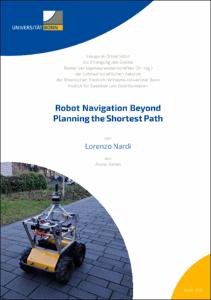Robot Navigation Beyond Planning the Shortest Path

Robot Navigation Beyond Planning the Shortest Path

| dc.contributor.advisor | Stachniss, Cyrill | |
| dc.contributor.author | Nardi, Lorenzo | |
| dc.date.accessioned | 2021-04-16T12:32:46Z | |
| dc.date.available | 2021-04-16T12:32:46Z | |
| dc.date.issued | 16.04.2021 | |
| dc.identifier.uri | https://hdl.handle.net/20.500.11811/9041 | |
| dc.description.abstract | Over the last decade, the demand for autonomous mobile robots has been growing continuously. Applications range from mobile manipulators operating on factory floors to autonomous cars driving in urban environments. A common requirement for all these tasks is the capability to autonomously navigate by making sequences of decisions in environments that are complex, dynamic, and uncertain. Mobile robots are often deployed in environments populated by humans or other moving objects and are required to perform safe and compliant navigation. Furthermore, real-world scenarios are typically characterized by uncertainty in the robot's perception, action execution, and belief about the world. Traditional approaches to robot navigation plan and follow the shortest path on static geometric representations of the environment. Such systems are often not adequate to capture the characteristics of real-world environments and may lead robots to perform behaviors that are sub-optimal in practice.
In this thesis, we address robot navigation in different real-world scenarios investigate a set of approaches that go beyond planning the shortest paths. We present solutions for robot navigation that are able to take into account and reason about the situation in which the robot navigates, the dynamics populating the environment, and the uncertainty about the world. We achieve this by exploiting available background knowledge. For example, we use publicly available maps of urban environments to planning policies for performing robust navigation on road networks under position uncertainty. Whereas, we exploit the paths previously experienced by the robot to generate safe and predictable behaviors that meet the user's preferences. We also present solutions for navigating in partially unknown environments by actively gathering information and by exploiting this knowledge to automatically improve robot navigation over time. We use the onboard robot perception during navigation in outdoor environments to automatically discover paths along which the impact of detrimental factors due to the terrain is lower. Furthermore, we exploit the observations about the traversability changes in an environment to plan anticipatory behaviors that lead the robot to encounter a reduced number of unforeseen obstacles while navigating. | en |
| dc.language.iso | eng | |
| dc.rights | In Copyright | |
| dc.rights.uri | http://rightsstatements.org/vocab/InC/1.0/ | |
| dc.subject | robotics | |
| dc.subject | mobile robots | |
| dc.subject | robot navigation | |
| dc.subject | path planning | |
| dc.subject.ddc | 004 Informatik | |
| dc.subject.ddc | 550 Geowissenschaften | |
| dc.title | Robot Navigation Beyond Planning the Shortest Path | |
| dc.type | Dissertation oder Habilitation | |
| dc.publisher.name | Universitäts- und Landesbibliothek Bonn | |
| dc.publisher.location | Bonn | |
| dc.rights.accessRights | openAccess | |
| dc.identifier.urn | https://nbn-resolving.org/urn:nbn:de:hbz:5-61951 | |
| ulbbn.pubtype | Erstveröffentlichung | |
| ulbbnediss.affiliation.name | Rheinische Friedrich-Wilhelms-Universität Bonn | |
| ulbbnediss.affiliation.location | Bonn | |
| ulbbnediss.thesis.level | Dissertation | |
| ulbbnediss.dissID | 6195 | |
| ulbbnediss.date.accepted | 06.07.2020 | |
| ulbbnediss.institute | Landwirtschaftliche Fakultät : Institut für Geodäsie und Geoinformation (IGG) | |
| ulbbnediss.fakultaet | Landwirtschaftliche Fakultät | |
| dc.contributor.coReferee | Iocchi, Luca | |
| ulbbnediss.contributor.orcid | https://orcid.org/0000-0001-6804-8308 | |
| ulbbnediss.contributor.gnd | 1235352706 |
Dateien zu dieser Ressource
Das Dokument erscheint in:
-
E-Dissertationen (1116)




